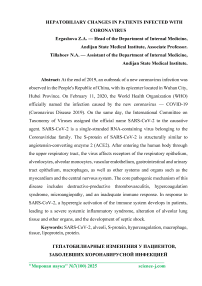Hepatobiliary changes in patients infected with coronavirus
Автор: Ergashova Z. A., Tillaboev N. A.
Журнал: Мировая наука @science-j
Статья в выпуске: 7 (100), 2025 года.
Бесплатный доступ
At the end of 2019, an outbreak of a new coronavirus infection was observed in the People's Republic of China, with its epicenter located in Wuhan City, Hubei Province. On February 11, 2020, the World Health Organization (WHO) officially named the infection caused by the new coronavirus - COVID-19 (Coronavirus Disease 2019). On the same day, the International Committee on Taxonomy of Viruses assigned the official name SARS-CoV-2 to the causative agent. SARS-CoV-2 is a single-stranded RNA-containing virus belonging to the Coronaviridae family. The S-protein of SARS-CoV-2 is structurally similar to angiotensin-converting enzyme 2 (ACE2). After entering the human body through the upper respiratory tract, the virus affects receptors of the respiratory epithelium, alveolocytes, alveolar monocytes, vascular endothelium, gastrointestinal and urinary tract epithelium, macrophages, as well as other systems and organs such as the myocardium and the central nervous system. The core pathogenic mechanism of this disease includes destructive-productive thrombovasculitis, hypercoagulation syndrome, microangiopathy, and an inadequate immune response. In response to SARS-CoV-2, a hyperergic activation of the immune system develops in patients, leading to a severe systemic inflammatory syndrome, alteration of alveolar lung tissue and other organs, and the development of septic shock.
Sars-cov-2, alveoli, s-protein, hypercoagulation, macrophage, tissue, lipoprotein, protein
Короткий адрес: https://sciup.org/140312057
IDR: 140312057
Текст научной статьи Hepatobiliary changes in patients infected with coronavirus
КОРОНАВИРУС БИЛАН КАСАЛЛАНГАН БЕМОРЛАРДА ГЕПАТОБИЛИАР ЎЗГАРИШЛАР
З.А.Ергашева- Андижон давлат тиббиёт институти ички касалликлар кафедраси мудири, доцент.
Н.А.Тиллабоев- Андижон давлат тиббиёт институти ички касалликлар кафедраси ассистенти.
Калит сузлар: САРС-СоВ-2, алвеола, С-оксил, гиперкоагуляция, макрофаг, тукима, липопротеин, оксил.
Introduction: The critical condition of COVID-19 is considered one of the manifestations of the cytokine storm, characterized by primary and secondary hemophagocytic lymphohistiocytosis or macrophage activation syndrome. The cytokine storm induces a distinct viral condition known as SARS-CoV-2-endotheliitis, in which damage to the microcirculatory system plays a significant role in pathogenesis. Based on autopsy materials and clinical presentations, the following morphological and clinical types of COVID-19 can be distinguished: cardiac, cerebral, intestinal, renal, hepatic, diabetic, thromboembolic (in cases of pulmonary artery thromboembolism), and septic (in the absence of bacterial and mycotic sepsis). In patients with COVID-19, the main pathogenic mechanisms of gastrointestinal tract injury include the direct effect of the virus on epithelial cells and the indirect effect of the cytokine storm on intestinal neuroregulation. Liver damage in COVID-19: Several studies have shown that liver injury in coronavirus infection mainly manifests as moderate cytolysis of hepatocytes and increased levels of liver transaminases. This process arises from the direct impact of the virus on hepatocytes. Research conducted in various provinces of China — such as Wuhan, Zhejiang, Zhuanzhou, and Lanzhou — reported that patients frequently experienced reduced appetite, nausea, vomiting, diarrhea, and altered sense of smell and taste. According to the American Gastroenterological Association, elevated liver enzyme levels are observed in 20–30% of patients with confirmed COVID-19 infection.
In a study by N. Chen et al., which examined 99 cases, more than 30% of patients exhibited signs of liver injury, including elevated ALT, AST, and C-reactive protein, along with reduced albumin levels down to 40 g/L. These findings varied across regions: 16% in Zhejiang Province, 6.2%–22% in Lanzhou, and the highest in Wuhan — 24.1% to 36.6%. Researchers attributed these differences to viral load and higher levels of viremia in the bloodstream. In terms of gender distribution, it was found that 58.2%–73.2% of infected patients were male, while 26.8%–41.9% were female.
Conclusion: There are currently no well-established, specific principles of hepatotropic therapy for liver dysfunction associated with COVID-19. Treatment strategies should focus on comprehensive assessment of the patient's condition and timely therapeutic interventions. Addressing decreased appetite, correcting hypoalbuminemia, restoring pulmonary ventilation, and administering antiplatelet agents, anticoagulants, and, importantly, hepatoprotectors are key in combating the cytokine storm. The effectiveness of treatment is confirmed by normalization of liver function tests, reduction of patient complaints, and progressive clinical improvement, indicating the adequacy of the chosen therapeutic approach.


